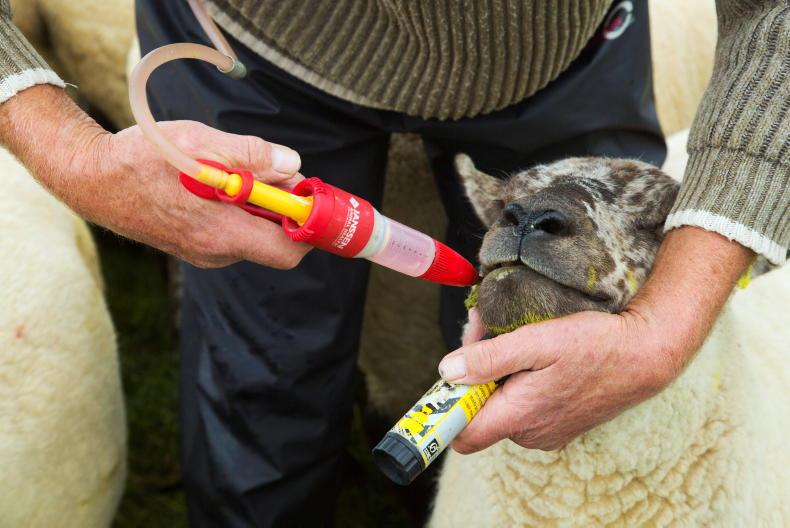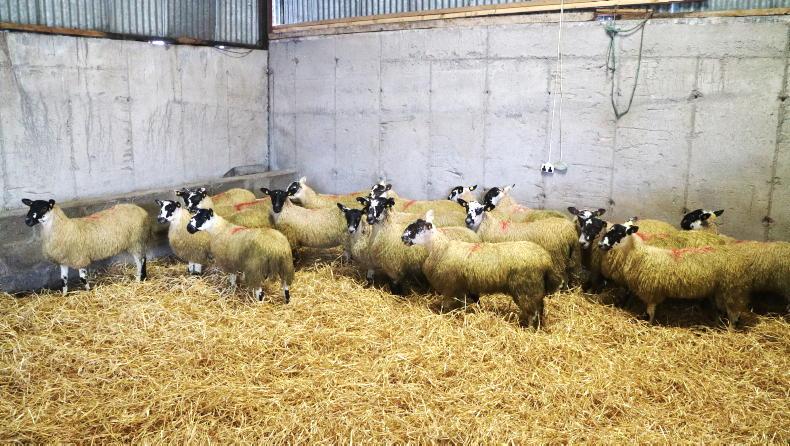Irish research has shown that anthelmintic resistance is a major and growing problem on Irish sheep farms. There are many farms that already have significant issues and for others if the rate of resistance developing is not slowed, it will have serious implications on animal performance. There are three areas farmers can focus on in the coming months.
Figure out what wormers are still working on your farm
Anthelmintic resistance means that wormers used are no longer killing all of the worms inside in the sheep’s digestive tract. It is not the case that the wormers have changed, it is the worms that have changed.
They have developed the ability to survive coming in contact with a wormer that would normally kill them. This is what we call anthelmintic resistance.
It is the ability of the stomach worms in the sheep’s digestive tract to survive a dose that would normally kill them.
Working out what products still work on your farm is pretty simple. It involves doing two faecal egg counts either one week or two weeks apart.
The first faecal egg count is to identify the number of worm eggs that are present at the time of dosing. This will be the reference number.
Once the animals have been treated for a period of seven days in the case of Levamisole (yellow)-based products or 14 days in the case of either benzimidazole (white) or macrocyclic lactone (clear)-based products a second faecal sample should be taken to see if the egg count has been eliminated or sufficiently reduced. We are looking for a reduction of at least 95%.
It is important that we take faecal samples from at least 10 lambs and it needs to be the same 10 lambs that are sampled on both occasions. Therefore, remember to identify the lambs with spray marker when they are first sampled.
Don’t dose your ewes for stomach worms unless there is a demonstrated need
Dosing ewes for stomach worms significantly increases the selection pressure for resistant worms. In the absence of a demonstrated need (hogget ewes rearing lambs, Haemonchus Contorus infection identified etc), there is no benefit in terms of improved performance from treating adult ewes for stomach worms.
The big downside of treating ewes for stomach worms is that from that point on and for a period of time (depending on the product used), the only worm eggs being passed out by the ewes are from worms that have survived the treatment (resistant worm eggs).
Make sure you avoid inadvertent treatment of ewes for stomach worms
These eggs will hatch into resistant worm larvae and may then infect lambs where treatment will be necessary to maintain performance.
Also, make sure you avoid inadvertent treatment of ewes for stomach worms.
This is the most common way in which ewes are treated for worms. For example, ewes are treated for liver fluke infection which is warranted but the product used is a combination product (fluke and wormer).
So now, all the ewes have inadvertently been treated for worms as well even though this was not intended.
Another example is where ewes are treated for external parasites (scab or lice) using an injectable macrocyclic lactone. The product being used will also have anthelmintic activity and alternative treatments such as plunge dipping may be more appropriate.

Don’t dose your ewes for stomach worms unless there is a demonstrated need.
So, to avoid inadvertent treatment of ewes for stomach worms, we need to ensure that we use products that are targeted only at the conditions that we are trying to treat. For example, if we are targeting liver fluke then use only a product that will kill liver fluke.
Take care when you are purchasing sheep
Stomach worms can only move in the digestive tracts of sheep. When buying sheep or moving sheep on to your farm from another holding always be conscious that they may be carrying worms that are resistant to anthelmintics.

House any sheep for a period of at least 48 hours after treatment and arrival on your farm.
Preventing the importation of resistant stomach worms on to your farm can be done by following a simple three-step procedure.
House any sheep for a period of at least 48 hours after treatment and arrival on your farm.Quarantine-drench purchased sheep using Zolvix and either a Levamisole-based product or a Macrocyclic Lactone-based product. Using Startect would also be an option but it is currently not available in Ireland.Turn the sheep out on to pasture that has been recently grazed by sheep to help dilute the effect of any resistant parasites that may have survived the quarantine treatment. The development of anthelmintic resistant parasites is a natural phenomenon that occurs. What is, however, under the control of each sheep farmer is the speed at which resistance develops on his/her farm. This can be as short as four years or as long as 50 years.
Irish research has shown that anthelmintic resistance is a major and growing problem on Irish sheep farms. There are many farms that already have significant issues and for others if the rate of resistance developing is not slowed, it will have serious implications on animal performance. There are three areas farmers can focus on in the coming months.
Figure out what wormers are still working on your farm
Anthelmintic resistance means that wormers used are no longer killing all of the worms inside in the sheep’s digestive tract. It is not the case that the wormers have changed, it is the worms that have changed.
They have developed the ability to survive coming in contact with a wormer that would normally kill them. This is what we call anthelmintic resistance.
It is the ability of the stomach worms in the sheep’s digestive tract to survive a dose that would normally kill them.
Working out what products still work on your farm is pretty simple. It involves doing two faecal egg counts either one week or two weeks apart.
The first faecal egg count is to identify the number of worm eggs that are present at the time of dosing. This will be the reference number.
Once the animals have been treated for a period of seven days in the case of Levamisole (yellow)-based products or 14 days in the case of either benzimidazole (white) or macrocyclic lactone (clear)-based products a second faecal sample should be taken to see if the egg count has been eliminated or sufficiently reduced. We are looking for a reduction of at least 95%.
It is important that we take faecal samples from at least 10 lambs and it needs to be the same 10 lambs that are sampled on both occasions. Therefore, remember to identify the lambs with spray marker when they are first sampled.
Don’t dose your ewes for stomach worms unless there is a demonstrated need
Dosing ewes for stomach worms significantly increases the selection pressure for resistant worms. In the absence of a demonstrated need (hogget ewes rearing lambs, Haemonchus Contorus infection identified etc), there is no benefit in terms of improved performance from treating adult ewes for stomach worms.
The big downside of treating ewes for stomach worms is that from that point on and for a period of time (depending on the product used), the only worm eggs being passed out by the ewes are from worms that have survived the treatment (resistant worm eggs).
Make sure you avoid inadvertent treatment of ewes for stomach worms
These eggs will hatch into resistant worm larvae and may then infect lambs where treatment will be necessary to maintain performance.
Also, make sure you avoid inadvertent treatment of ewes for stomach worms.
This is the most common way in which ewes are treated for worms. For example, ewes are treated for liver fluke infection which is warranted but the product used is a combination product (fluke and wormer).
So now, all the ewes have inadvertently been treated for worms as well even though this was not intended.
Another example is where ewes are treated for external parasites (scab or lice) using an injectable macrocyclic lactone. The product being used will also have anthelmintic activity and alternative treatments such as plunge dipping may be more appropriate.

Don’t dose your ewes for stomach worms unless there is a demonstrated need.
So, to avoid inadvertent treatment of ewes for stomach worms, we need to ensure that we use products that are targeted only at the conditions that we are trying to treat. For example, if we are targeting liver fluke then use only a product that will kill liver fluke.
Take care when you are purchasing sheep
Stomach worms can only move in the digestive tracts of sheep. When buying sheep or moving sheep on to your farm from another holding always be conscious that they may be carrying worms that are resistant to anthelmintics.

House any sheep for a period of at least 48 hours after treatment and arrival on your farm.
Preventing the importation of resistant stomach worms on to your farm can be done by following a simple three-step procedure.
House any sheep for a period of at least 48 hours after treatment and arrival on your farm.Quarantine-drench purchased sheep using Zolvix and either a Levamisole-based product or a Macrocyclic Lactone-based product. Using Startect would also be an option but it is currently not available in Ireland.Turn the sheep out on to pasture that has been recently grazed by sheep to help dilute the effect of any resistant parasites that may have survived the quarantine treatment. The development of anthelmintic resistant parasites is a natural phenomenon that occurs. What is, however, under the control of each sheep farmer is the speed at which resistance develops on his/her farm. This can be as short as four years or as long as 50 years.








 This is a subscriber-only article
This is a subscriber-only article











SHARING OPTIONS: